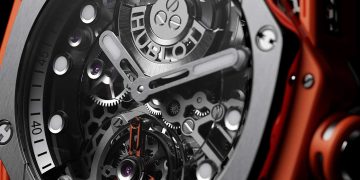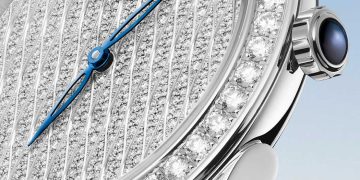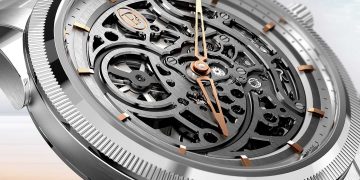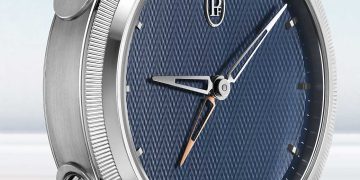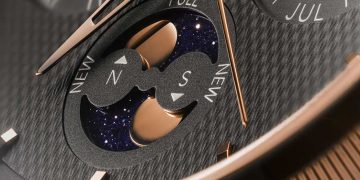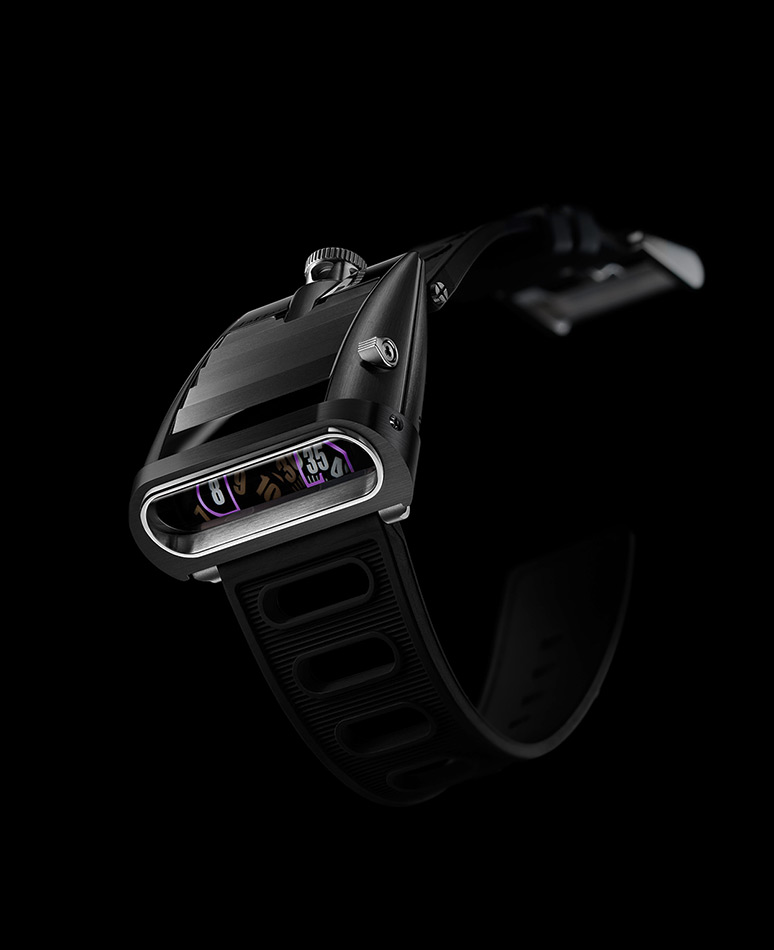
Black. As a colour, or to be more accurate, an absence of colour, there’s nothing quite like it. Other colours go in and out of fashion, but black is always in. So adding a coat of black paint, a.k.a. PVD, to the case of the super-car-inspired HM5 would appear to be the sensible thing to do.
But since when has MB&F taken the sensible route?
While Horological Machine No.5’s striking, angular case architecture faithfully echoes the form of the streamlined supercars that inspired it, those sharp corners would make a black PVD coating more susceptible to being scratched than a more conventional design.
So rather than take the easier path of adding a black PVD coat to the existing HM5 case, MB&F went in search of a solid black material that:
- Could be polished and finished like metal.
- Felt as solid and substantial as metal.
- Was as hard as steel.
Unfortunately, no material with those properties existed. So MB&F asked a specialist supplier to develop one.
It took a full 18 months, but they finally did: MB&F calls it CarbonMacrolon.
CarbonMacrolon is a dense black polycarbonate resin reinforced with carbon nanotubes. It can be polished and finished like steel, feels as solid as steel and is as hard as steel. And it is black right through, so no surface coatings to scratch off.
Horological Machine No5 CarbonMacrolon (HM5 CM): Super car styling; bi-directional jumping hours, compartmentalised Engine in its own water-resistant inner case; functioning louvres allowing light in to charge the Super-LumiNova indication discs; and water-draining exhaust ports.
All this in a sleek, polished and satinised, pitch-black CarbonMacrolon case with an eye-catching iridescent purple automatic winding rotor and complementary purple highlights around the displays. Black, it’s the new black.
HM5 CM is a limited edition of 66 pieces.
Horological Machine No5:
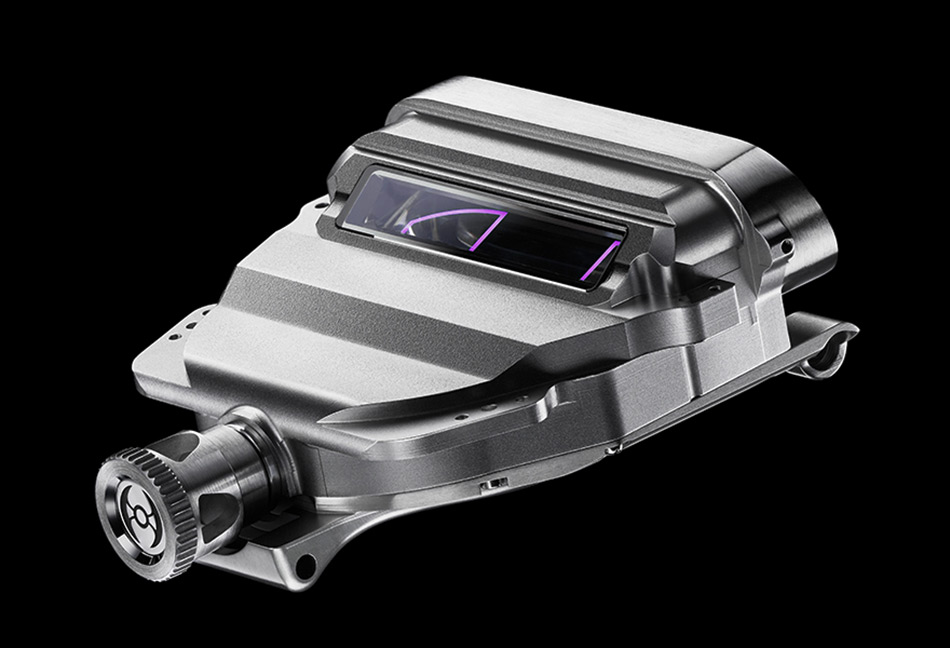
Makrolon®: It’s no exaggeration to state that when Bayer introduced the revolutionary polycarbonate material Makrolon® in 1963, it changed the world. The virtually unbreakable material is used in an incredible range of diverse applications including CDs, water-resistant camera housings, medical devices, contact lenses, sunglasses, laptop cases, aircraft wing and fuselage components, canopies for jets and helicopter windscreens. With its high dimensional stability, excellent heat resistance, ease of moulding, long life and eco-friendly reusability, Makrolon® quickly became, and still is, one of the most versatile thermoplastics ever invented.
CarbonMacrolon: Developed specifically for MB&F, CarbonMacrolon is a composite material composed of an anthracite polymer matrix injected with carbon nanotubes, which add strength and rigidity. Carbon nanotubes offer superior tensile strength and stiffness than traditional carbon fibre reinforcing. MB&F’s CarbonMacrolon is a solid black material that is heavy, hard, and can be polished and finished like metal.
Inspiration and realisation: For MB&F founder Maximilian Büsser, growing up as a child in the 1970s meant living in a constant state of awe and wonder. Supersonic jets flew through the air and through space; American muscle cars dominated the silver screen in road movies and fuelled the imagination.
The Lamborghini Miura launched a new genre of Italian super cars that looked as though they could break the sound barrier while standing still (creations that led the young Max to dream of being a car designer). Lasers, transistors, microwaves, hovercrafts and jet-packs gave the impression that the difference between science fiction and science fact was just a matter of when, not if.
And with the arrival of quartz wristwatches, watch designs were transformed from looking like something your grandfather wore, to something Captain Kirk might wear. HM5 takes these childhood dreams and gives them a new lease of life.
“Imagine telling somebody in 1972 that in 2012, most people would be wearing round watches with round dials and three hands. That would sound crazier and more far-fetched than the idea of living on Mars!” Maximilian Büsser
Case: The wedge-shaped case of HM5 has unmistakable references to the low-slung supercars of the epoch.
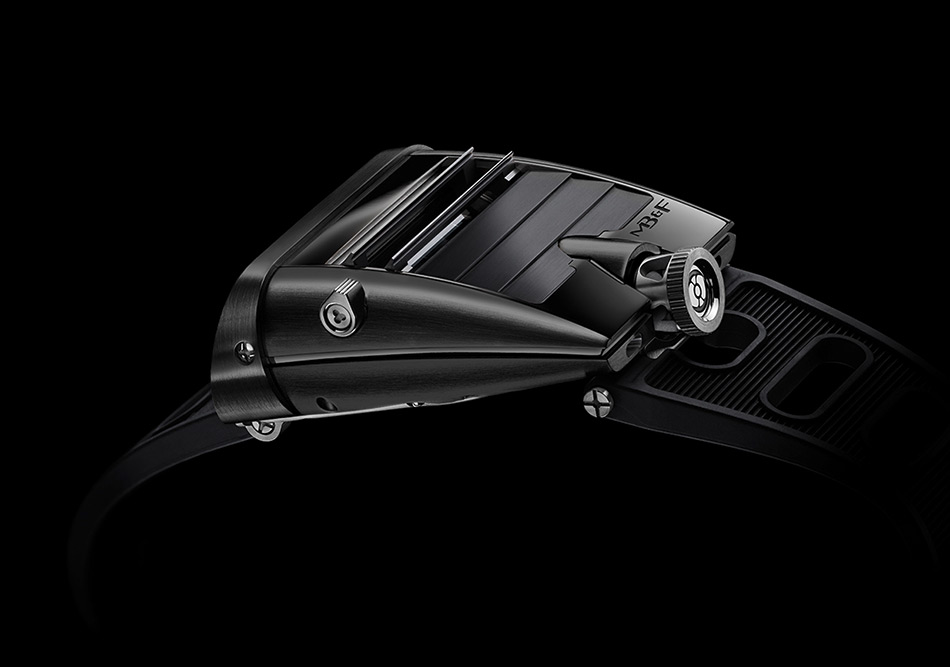
The purpose of the louvres on these awe-inspiring cars was to restrict sunlight (and heat) from entering the near horizontal rear window. The functional louvres on HM5 do the opposite in that they open to allow light down onto the Super-LumiNova numbers on the hours and minutes indication disks to charge them. The disks are actually flat on top of the movement (under the louvres), not vertically at the front of the case where they appear to be thanks to some optical magic. Opening and closing the louvres also changes the dial’s light intensity. The louvres are opened and closed by a slide set into the side of the case.
Another distinguishing feature of supercars are large dual exhaust pipes that are usually seen accompanied by a roar of engine noise and smoking rubber. But HM5’s exhausts are not there to expel combustion gases in a throaty roar, but to drain water in case – like James Bond’s Lotus in ‘The Spy Who Loved Me’ – HM5 gets wet.
And no futurist icon of the 1970s is complete without a jet. HM5’s ergonomically sculptured crowns looks as though it could just as easily power a rocket to the Alpha Centauri, or the Batmobile, as it powers Horological Machine No. 5 CarbonMacrolon into the future.
To minimise potential damage, the crown winding stem is guided by three radial bearings, ensuring it can only be pulled/pushed when perpendicular to the movement.
Indications and reflective prism: The actual hour and minute time displays on HM5, i.e. the numbered rotating disks, are relatively simple: overlapping disks (one for hours, one for minutes) are completely covered in Super-LumiNova, which then has large 8mm numerals created by masking all of the lume except for the numbers.
The disks rotate flat on top of the movement and yet we see the time indications vertically in a ‘dashboard’ at the front of the case. To achieve this, MB&F worked with a high-precision optical glass supplier to develop a sapphire crystal reflective prism that bent light from the disks 90° as well as magnify it by 20% to maximise legibility.
The sapphire prism is wedge-shaped with the angles precisely calculated to ensure that light is reflected from the horizontal indications to the vertical rather than refracted (bent). A convex lens at the front provides the magnification. Sapphire crystal is much more difficult to work to optical precision than glass and it took considerable development and meticulous care in production to create crystals that reflected and bent light without the slightest distortion.
Because the time is reflected, the numbers are printed on the disks as mirror images so that they display correctly on the ‘dial’. The glass on the front is not black but dark-tinted so that it is possible to see time arriving and departing and the numbers have an iridescent purple outline, reminiscent of the glowing instruments of a supercar on a high-speed road trip at night.
The vertical forward-facing display makes HM5 an excellent driver’s watch as there is no need to lift your wrist from the steering wheel to read the display.
Engine and internal housing: As with any supercar, the best often lies under the hood and looking below the surface of the Horological Machine No. 5 CarbonMacrolon case reveals a surprise: another case! Like a Russian Matryoshka doll, peeling away the outer layer reveals a second case beneath.
The reason for housing the Engine in an inner container is for water resistance. Those supercar louvres let in water as well as light − the reason for those dual exhaust ports – so to protect the high-performance Engine from moisture as well as shocks, it is housed in its own stainless steel shell. This inner case is similar to the ridged chassis of a car on which the external coachwork/body is attached.
Jean-François Mojon, Vincent Boucard and their team at Chronode developed the HM5 Engine/complication. It may appear simple, but it’s complicated! The jumping hours are bi-directional, enabling the time to be easily set both forwards and backwards. The two mineral glass disks of the hours and minutes are supported by a flat wide bridge. The disks overlap as much as possible to maximise their diameter and space for large legible numerals.
Turning HM5 CM over reveals the Engine, with its stunning iridescent purple 22k gold battle-axe shaped ‘mystery’ winding rotor, fast oscillating balance and stunning hand-finished bridges, visible through the sapphire crystal display back set into the water-resistant Engine container.
Technical details Horological Machine No5
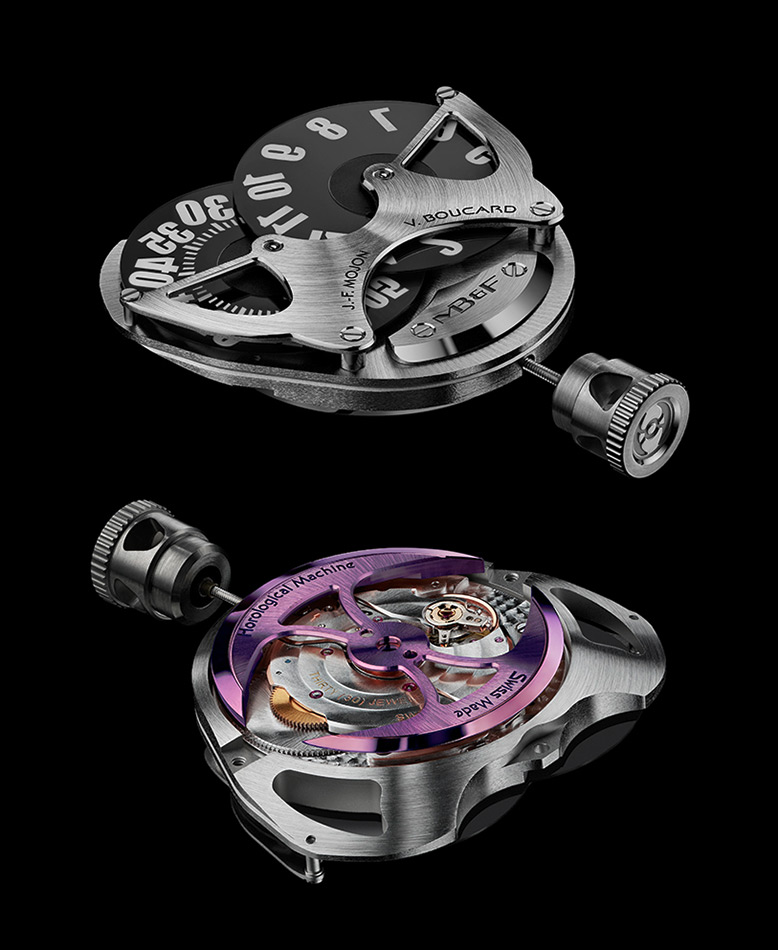
CarbonMacrolon
Limited edition of 66 pieces in CarbonMacrolon
Engine:
Three-dimensional horological engine developed by Jean-François Mojon and Vincent Boucard of Chronode
Powered by a Sowind gear train
Iridescent purple 22k gold battle-axe ‘mystery’ automatic winding rotor
Power reserve: 42 hours
Balance frequency: 28,800bph/4Hz
Number of components: 224
Number of jewels: 30
Engine housed in a water-resistant, stainless steel inner container
Functions/indications:
Minutes and bi-directional jumping hours displayed by reflective sapphire crystal prism with integrated magnifying lens
Slide to open/close louvres on case top
Case:
CarbonMacrolon with internal water-resistant steel engine container
Slide button to open/close louvres
Exhaust ports to drain water
Dimensions: 51.5mm x 49mm x 22.5mm
Number of components: 80
Water resistance of engine container: 30m / 90’ / 3atm
Sapphire crystals:
Smoked optical grade sapphire crystal with anti-reflective coating and 20% magnification. Sapphire crystal on back with anti-reflective treatment on both faces.
Strap & Buckle:
Sculpted rubber strap, titanium tang buckle
‘Friends’ responsible for HM5 CarbonMacrolon
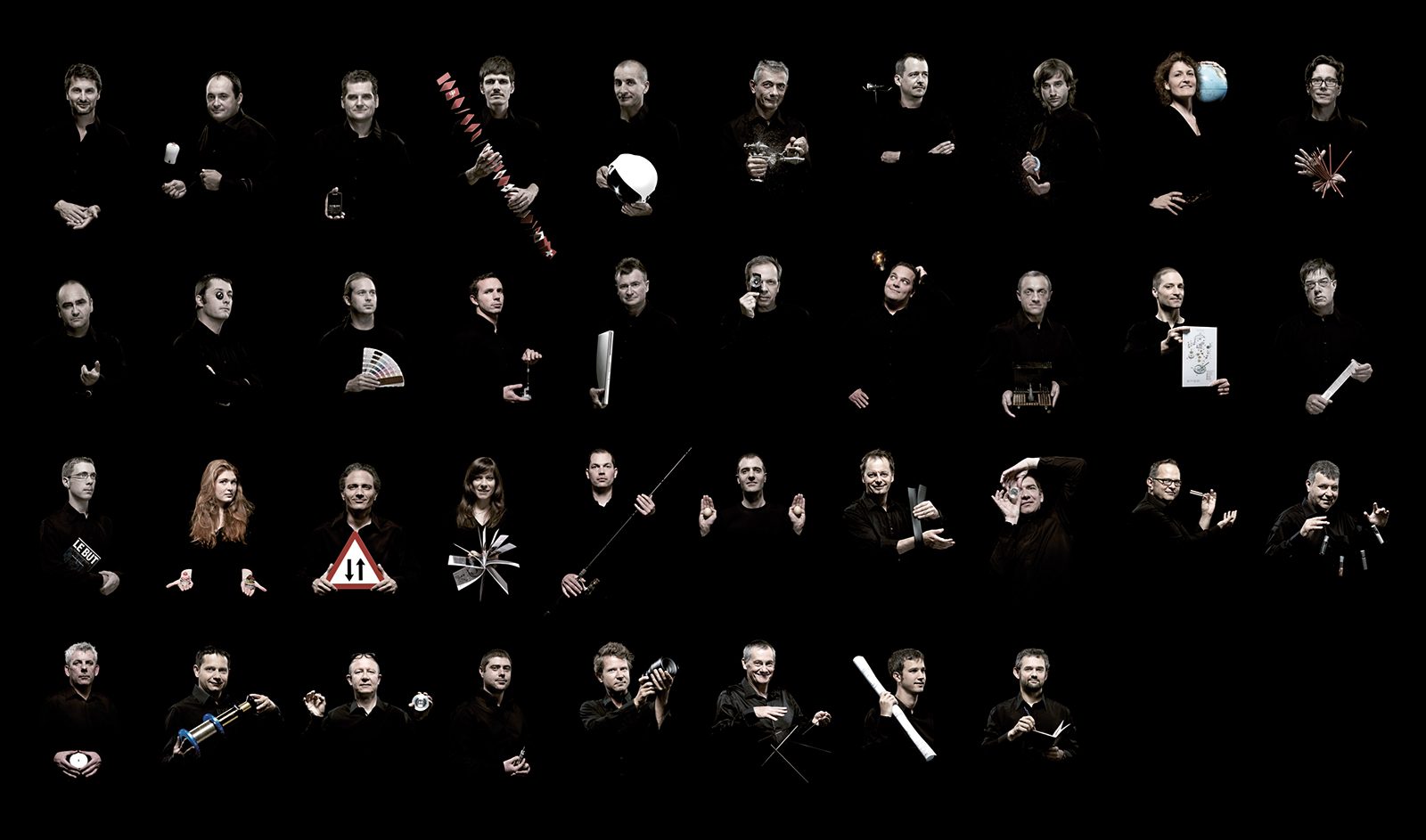
Concept: Maximilian Büsser / MB&F
Product design: Eric Giroud / Eric Giroud Design Studio
Development and production management: Serge Kriknoff / MB&F
R&D: Guillaume Thévenin and Ruben Martinez / MB&F
CarbonMacrolon case: Michel Hoff / Injector SA
Case components: Julien Ducommun / Niru Group
Movement development: Jean-François Mojon and Vincent Boucard / Chronode
Movement base: Stefano Macaluso and Raphael Ackermann / Sowind and Denis Villars / Cendres + Métaux Galétan SA
Additional module: Benjamin Signoud / AMECAP
Steel movement parts: Alain Pellet / Elefil
Wheels: Jean-Marc Naval / Rouages SA
Hand-finishing of movement components: Jacques-Adrien Rochat and Denis Garcia / C-L Rochat
Movement assemblage: Didier Dumas, Georges Veisy, Anne Guiter and Emmanuel Maitre/ MB&F
In-house machining: Alain Lemarchand / MB&F
After-Sales service: Florian Courbat / MB&F
Quality Control: Cyril Fallet / MB&F
Case and buckle construction and production: Dominique Mainier and Bertrand Jeunet / G&F Châtelain
Specific crown of the louvre mechanism: Jean-Pierre Cassard / Cheval Frères SA
Sapphire glass / Prism: Martin Stettler / Stettler Sapphire AG
Hour and minute disks: Jean-Michel Pellaton and Gérard Guerne / Bloesch SA
Strap: Thierry Rognon / Valiance
Presentation case: Olivier Berthon / ATS Développement
Production logistics: David Lamy and Isabel Ortega of MB&F
Marketing communications: Charris Yadigaroglou, Virginie Meylan and
Juliette Duru / MB&F
M.A.D.Gallery: Hervé Estienne / MB&F
Sales: Luis André and Patricia Duvillard / MB&F
Graphic design: Damien Seydoux / MB&F
Product photography: Maarten van der Ende
Portrait photography: Régis Golay / Federal
Website: Stéphane Balet and Victor Rodriguez / Sumo Interactive
Film: Marc-André Deschoux / MADinSwitzerland
Texts: Ian Skellern and Steven Rogers / Underthedial
MB&F – The Genesis of a Concept Laboratory
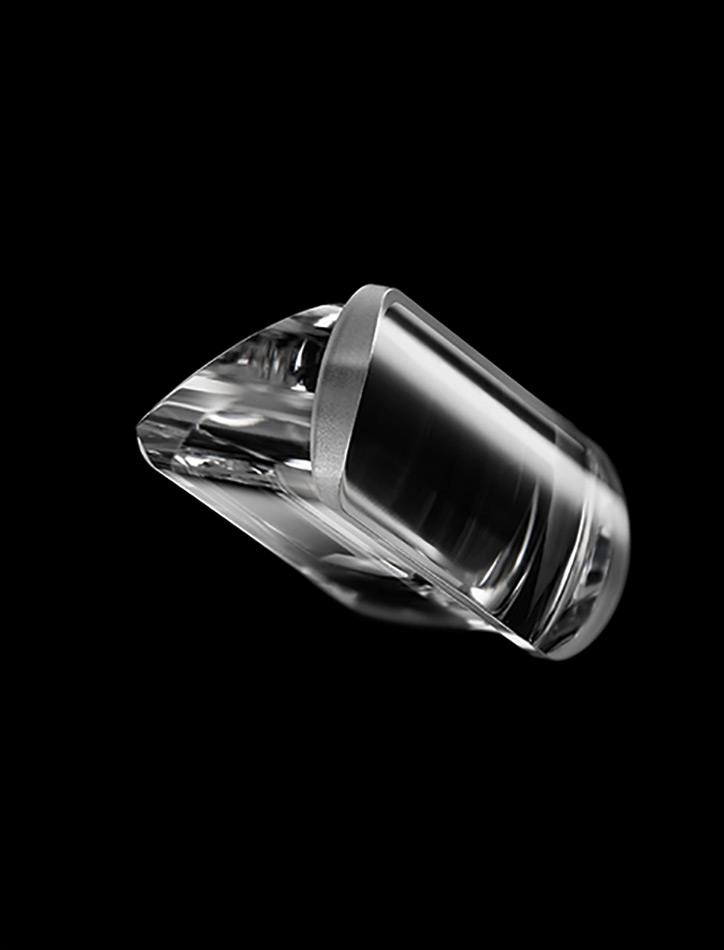
The projects that gave Maximilian Büsser the most pleasure and personal satisfaction during his 15 years managing prestigious watch brands were those working with talented independent watchmakers. An idea for his own personal utopia emerged: that of creating a company dedicated solely to designing and crafting small series of radical concept watches in collaboration with talented professionals he both respected and enjoyed working with. The entrepreneur in Büsser brought the idea to reality.
MB&F is not a watch brand. It is an artistic and micro-engineering concept laboratory in which collectives of independent horological professionals are assembled each year to design and craft radical Horological Machines. Respecting tradition without being shackled by it enables MB&F to act as a catalyst in fusing traditional, high-quality watchmaking with cutting-edge technology and avant-garde three-dimensional sculpture.
In 2007, MB&F unveiled their first Horological Machine, its sculptured, three-dimensional case and beautifully finished Engine setting the standard for the idiosyncratic Machines that followed – Machines that tell the time, rather than Machines to tell the time. In 2011, MB&F launched their round-cased Legacy Machine collection. These more classical pieces (classical for MB&F that is) pay tribute to 19th century watchmaking excellence by reinterpreting complications from the great horological innovators to create contemporary objets d’art. Since then, MB&F alternate between launching an exciting new Horological Machine and an historically-inspired Legacy Machine.
Biography – Maximilian Büsser
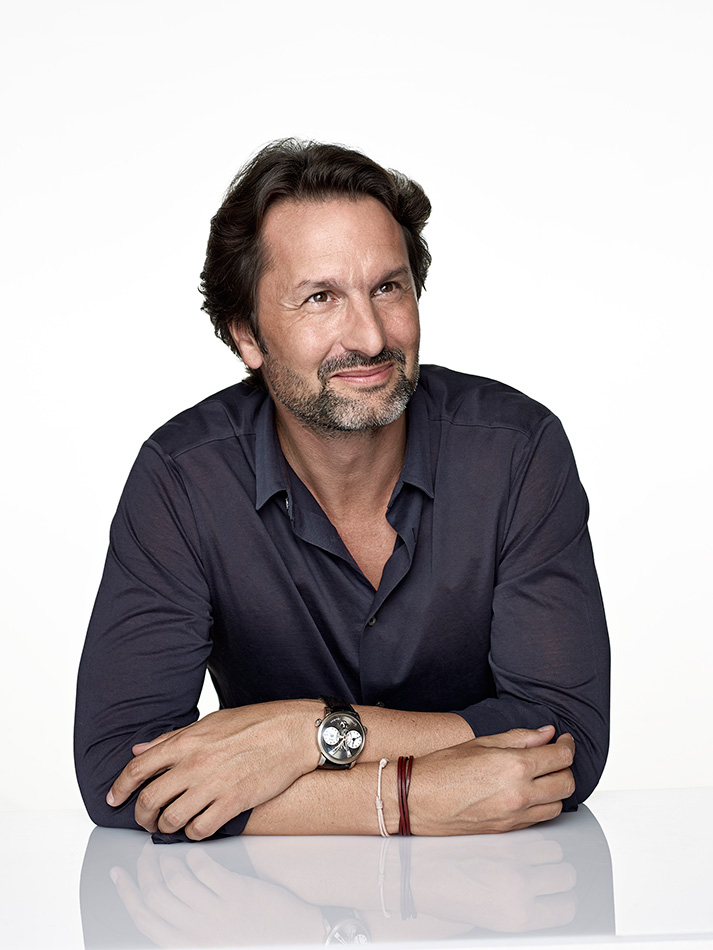
Maximilian Büsser was born in Milan, Italy, before moving at an early age to Lausanne, Switzerland where he spent his youth. Growing up in a multi-cultural environment and family – his father was a Swiss diplomat who met his mother, an Indian national, in Mumbai – led Büsser to develop a cross-cultural, broad-based approach to life and to business.
In July 2005, at the age of 38, Büsser created the world’s first horological concept brand: MB&F (Maximilian Büsser & Friends), in which he is now partnered with Serge Kriknoff. Büsser’s dream with MB&F is to have his own brand dedicated to developing radical horological concepts by working in small, hyper-creative groups composed of people he enjoys working with.
Entrepreneurship is Maximilian Büsser’s forte. In 1998, when only 31, he was appointed Managing Director of Harry Winston Rare Timepieces in Geneva. During his seven years there Büsser developed the company into a fully-fledged and well-respected haute horlogerie brand by developing the strategy, products, marketing and worldwide distribution, whilst integrating design, R&D and manufacturing in house. The results were a 900% increase in turnover and the positioning of Harry Winston as one of the leaders in this very competitive segment.
Maximilian Büsser’s love for high-end horology was nurtured by his first employer, Jaeger-LeCoultre. During his seven years in the senior management team during the 1990s, JLC strongly increased its profile and multiplied its turnover tenfold. Büsser’s responsibilities at Jaeger-LeCoultre ranged from Product Management & Development to Sales & Marketing for Europe.
Büsser graduated in 1991 with a Masters in Microtechnology Engineering from the Swiss Federal Institute of Technology, Lausanne.

